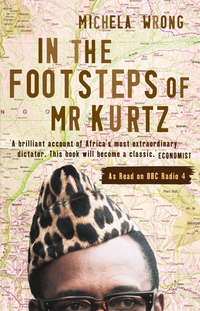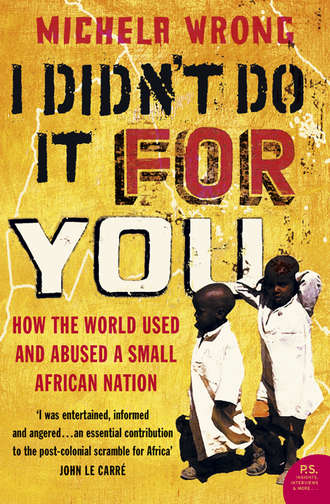
Полная версия
I Didn’t Do It For You: How the World Used and Abused a Small African Nation

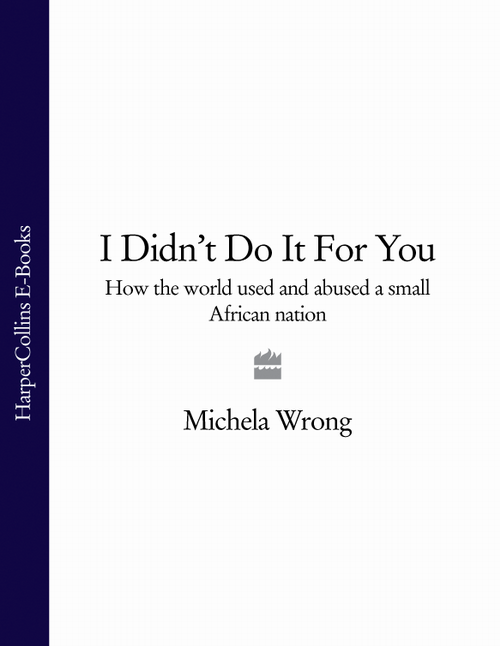
I Didnât Do It For You
How the World Used and Abused a Small African Nation
Michela Wrong

To Elena and Silvia Harty, as promised
Table of Contents
Cover Page
Title Page
Dedication
Maps
Foreword
CHAPTER 1 The City Above the Clouds
CHAPTER 2 The Last Italian
CHAPTER 3 The Steel Snake
CHAPTER 4 This Horrible Escarpment
CHAPTER 5 The Curse of the Queen of Sheba
CHAPTER 6 The Feminist Fuzzy-Wuzzy
CHAPTER 7 âWhat do the baboons want?â
CHAPTER 8 The Day of Mourning
CHAPTER 9 The Gold Cadillac Site
CHAPTER 10 Blow Jobs, Bugging and Beer
CHAPTER 11 Death of the Lion
CHAPTER 12 Of Bicycles and Thieves
CHAPTER 13 The End of the Affair
CHAPTER 14 The Green, Green Grass of Home
CHAPTER 15 Arms and the Man
CHAPTER 16 âWhere are our socks?â
CHAPTER 17 A Village of No Interest
CHAPTER 18 âItâs good to be normalâ
Chronology
P.S. Ideas, interviews & features â¦
Interview
About the book
Read on
Glossary and acronyms
Notes
Other sources
Index
Acknowledgements
About the Author
Praise
By the same author
Copyright
About the Publisher
Maps
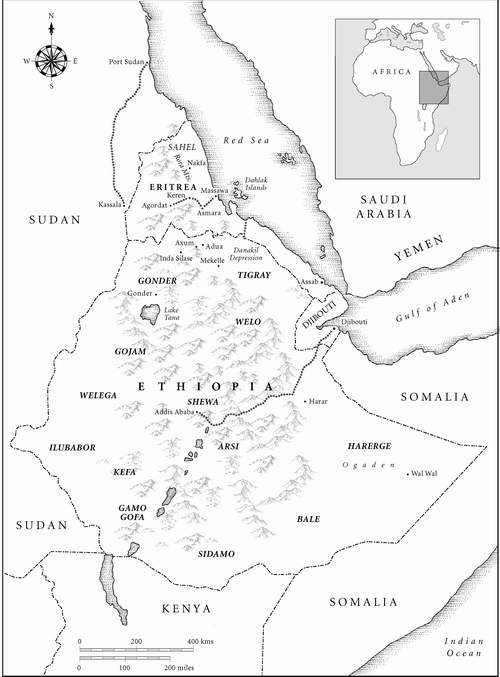
EritreaâEthiopia border as defined by the International Boundary Commission on April 13, 2002
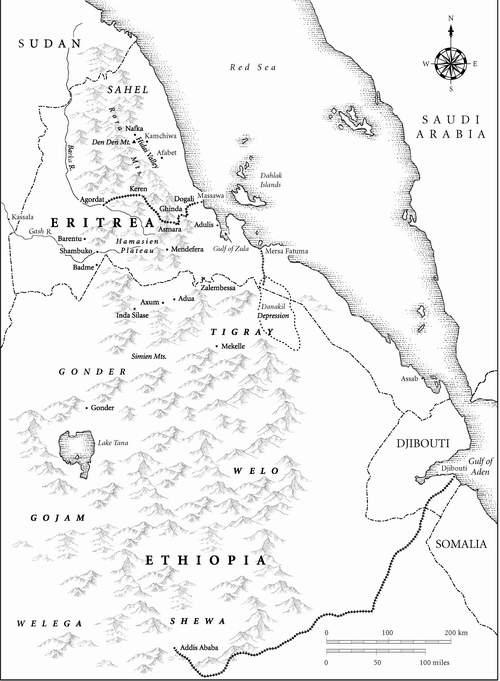
EritreaâEthiopia border as defined by the International Boundary Commission on April 13, 2002
Foreword
It was well past midnight, and in Cairo airportâs transit lounge it was clear most passengers had already entered the trance-like state of passivity that accompanies long-distance travel. Outside, in the fluorescent glare of the hallway, a trio of stranded Senegalese women traders, majestic in their colourful boubous, were shouting, with operatic volume, at the Egyptian airport staff behind the counter, who were responding with an icy silence that said more about Arab attitudes towards black Africa than direct insults ever could. But here in transit, eyes had glazed over, the energy had leached from the air. A group of Nigerian youths, whose clothes gave off the nose-tickling aroma of dried fish, lay slumped in the plastic orange scoop seats, spines turned to jelly. They were being messed around by EgyptAir staff, who couldnât be bothered to check them in to the airport hotel their tickets entitled them to. They seemed past caring, anger had long since given way to exhaustion.
A few seats away, a middle-aged Pakistani businessman was fighting the prevailing mood of stupefied indifference. Visiting cards at the ready, he was in defiantly chatty mode, and was taking the fact that the airline had mislaid his luggage in his stride. (âEgyptAir no good,â he confided. âHmm, yes, I know.â) He worked for a company that manufactured soap powder, he said, and constantly travelled the African continent and the Middle East, sizing up possible markets for his multinational.
âAnd you, what do you do?â
âIâm a journalist. Iâm writing a book about Eritrea. Thatâs where Iâm going now.â
His brow furrowed, he must have misheard. âYou are writing a book about Algeria?â
âNo, not Algeria. Eritrea.â
âNigeria?â He was floundering now.
âNo.â
A wild guess. âAl-Jazeera?â
âNo, no. Eritrea.â Enunciating the word with the exaggerated lip movements of a teacher addressing a class with special needs, I searched for some explanatory shorthand. âYou know. Small country on the Red Sea. Used to be part of Ethiopia. Itâs only two hoursâ flight from here. Iâm waiting for my connection.â
There was a brief silence. This seasoned traveller looked both flummoxed and embarrassed. âIâm sorry. But Iâve simply never heard of the place.â
It was a conversation that was to keep recurring throughout the four years I spent writing this book. Mention that I was researching Eritrea and the reaction would be a sympathetic nod and ruminative silence as the other person tried to work out whether I was talking about a no-frills airline, a Victorian woman novelist or, perhaps, some obscure strain of equine disease. The same ignorance, I discovered, extended to the written record. I read books on Art Deco and Modernist architecture that made no mention of the city of Asmara, containing some of the worldâs most perfect examples of the styles. I waded through weighty accounts of the American intelligence services that either never referred to the fact that Eritrea had been the site of one of Washingtonâs key listening posts, or dismissed it in a few paragraphs. I dusted off biographies on the suffragette Sylvia Pankhurst that treated her involvement in the Horn of Africa as little more than an eccentric coda to her life. Whether in conversation or in print, Eritrea rang few bells.
At first, it amused me, then, slowly, it began to irritate. My annoyance grew in parallel with my knowledge, for the deeper I delved, the clearer it became that Eritrea had never been the obscure backwater suggested by the polite, blank expressions. Its narrative was entwined with those of colonial empires and superpowers, its destiny had engaged presidents in the White House and leaders in the Kremlin. It had obsessed emperors who believed themselves descended from Solomon and preoccupied dictators who took the Fascist salute.
I became increasingly defensive as I staked out claims to relevance, spelling out links and liaisons obliterated by the passage of time. âYou know, we ran the place for ten years,â I would say, talking to a fellow Briton. Or, if it was an American: âActually, the US had one of its most important spy bases in Eritrea during the Cold War.â As for the Italians, I heard myself speaking with the fixed-eye testiness of someone lost in a private obsession: âIt was your oldest colony, your âfirst-bornâ. Didnât they teach you that at school?â
History is written â or, more accurately, written out â by the conquerors. If Eritrea has been lost in the milky haze of amnesia, it surely cannot be unconnected to the fact that so many former masters and intervening powers â from Italy to Britain, the US to the Soviet Union, Israel and the United Nations, not forgetting, of course, Ethiopia, the most formidable occupier of them all â behaved so very badly there. Better to forget than dwell on episodes which reveal the victors at their most racist and small-minded, cold-bloodedly manipulative or simply brutal beyond belief. To act so ruthlessly, yet emerge with so little to show for all the grim opportunism; well, which nation really wants to remember that?
The problem, as the news headlines remind us every day, is that while the victims of colonial and Cold War blunders do not pen the story that ends up becoming the worldâs collective memory, they also donât share the conquerorsâ lazy capacity for forgetfulness. Any regular Western visitor to the developing world will be familiar with that awkward moment when a local resident raises, with a passion and level of forensic detail that reveals this is still an open wound, some injustice perpetrated long ago by the colonial master. Baffled, the traveller registers that the forgotten massacre or broken treaty, which he has only just discovered, is the keystone on which an entire communityâs identity has been built. âGosh, why are they still harping on about that?â he thinks. âWhy canât they just move on? We have.â It is a version of the âWhy do they hate us so?â question a shocked America asked in the wake of September 11. Eritreaâs story provides part of the answer to that query. It is very easy to be generous with your forgiving and forgetting, when you are the one in need of forgiveness. A sense of wounded righteousness keeps the memory sharp. Societies that know they have suffered a great wrong have a disconcerting habit of nursing their grievances, keeping them keen through the decades.
Itâs hard to think of another African country that was interfered with by foreign powers quite so thoroughly, and so disastrously, as Eritrea. âMy country has a lot of history,â an Eritrean academic once told me. âIn fact,â he added, with lugubrious humour, âthatâs all it has.â And like Palestine and Rwanda, East Timor or Northern Ireland, Eritreaâs fate has illustrated the truth that, when it comes to destabilizing regions and disturbing the sleep of nations, size doesnât matter. When the UN laid the groundwork for a guerrilla war by ushering in a flawed constitution in the 1950s, Eritreaâs population was slightly more than 1 million. When Ethiopiaâs mighty army lost to what its leadership had dismissed as âa handful of banditsâ in 1991, Eritreaâs residents numbered less than the population of Greater Manchester today. A province no larger than a medium-sized American state, most of it uninhabited, raised a clamour so loud that in the end it could no longer be ignored. Eritreaâs history resembles one of those expensive television advertisements in which the flicking of a tiny cog leads to the toppling of a spanner, which sends windscreen wipers gyrating, a tyre rolling â a long chain of cause and effect which eventually climaxes in the revving of a sleek family car. Grudges which are not addressed acquire a momentum all their own, shuddering across continents and centuries until they erupt in a thunderous roar. âSmallâ conflicts, left to fester long enough, have an uncanny way of bringing down empires.
Written as Eritrea faces one of the toughest challenges in its history, this is a book about betrayal, repeated across the generations, and how the expectation of betrayal can both create an extraordinary inner strength and distort a national psyche, sending a community down strange and lonely paths.
Despite the glazed-eye reactions I encountered, Eritreaâs history is not an abstruse irrelevance. The peculiar mulishness of its citizens did not spring spontaneously into existence. Eritreaâs seeming idiosyncrasies have entirely logical roots, roots that â to the Western reader â reach surprisingly close to home. They cannot be unpicked from the vainglorious dreams of a 19th-century Italian man of letters, an English suffragetteâs clash with snooty British officialdom and the pantomime antics of several generations of GIs. In a new era of superpower intervention abroad, in which the War on Terror has replaced the fight against Communism as justification for Western military adventurism, the old cliché about the dangers of forgetting historyâs mistakes holds truer than ever. Part and parcel of our own story, Eritrea should serve as a lasting cautionary tale, encouraging us to pause and ponder before rushing in. We forget the roles we play in such far-off outposts at our peril.
CHAPTER 1 The City Above the Clouds
âThat thin air had a dream-like texture, matching the porcelain-blue of the sky, with every breath and every glance he took in a deep anaesthetising tranquillity.â
Lost Horizon, James Hilton
Whenever I land in Asmara, a novel read in adolescence comes to mind. It tells the story of a small plane whose pilot turns hijacker. Crash-landing in a remote part of the Himalayas, he dies of his injuries before he can explain his bizarre actions to the dazed passengers. They emerge from the wreckage to be greeted by a wizened old monk, who leads them to a citadel hidden above the peaks, a secret city whose existence has never been recorded on any map. They are welcomed to Shangri-La, where, breathing the chill air that wafts from the glaciers and surveying the world from a tremendous height, they begin reassessing their lives with the same calm detachment and cosmic clarity as the monks. But as time goes by, they learn they must make a terrible choice. They can stay in Shangri-La and live forever, for their hosts have discovered something approaching the secret of eternal youth. Or they can plunge back into the hurly-burly of the life they knew and eventually die as ordinary mortals, grubbing around down on the plains.
Flying in from Cairo, where even during an early-morning stopover the air blasts radiator-hot through the open aircraft door, one always has the sense of landing in a capital located where, by rights, it has no place to be.
Even in the satellite photos Eritrea, a knobbly elongated triangle lying atop Ethiopia, its giant neighbour to the south, seems an inhospitable destination, a landscape still too raw for human habitation. The route the planes follow takes you over mile upon relentless mile of dun-coloured desolation, made beautiful only by the turquoise fringe where sand meets sea; a beauty that you know would evaporate if ever you ventured down to sea level to brave the suffocating heat. A spray of islands, the Dahlak, shows only the faintest dusting of green. The rolling coastal sands, which show up from outer space as a strip of pearly-pink, run from the port of Massawa north-west to the border of Sudan. To the south-east, where a long, thin finger of land points towards Djibouti, the rock turns a forbidding black. Volcanic lava flows have created a landscape grimmer than the surface of the moon. This is the infamous Danakil Depression, said to be the hottest place on earth, where summer temperatures touch heights feared by even the whippet-thin Afar tribesmen. Behind this flat coastal strip, the land billows up to form a magnificent escarpment, the ripples of hills deepening into jagged waves of dark rock, a giant crumple of mountain creased by empty ravines and bone-dry river beds. It is only in the triangleâs western corner, where Eritrean territory juts and bulges into northern Ethiopia, that rivers â the Gash and the Barka â flow all year round. Here in the western lowlands, the gradient finally levels off, wrinkles smooth away and the arid sands cede to the deep green that spells rain, the shade of trees, the blessing of crops.
But it is not the bleakness, but the altitude that makes Asmaraâs location as improbable as that of Shangri-La. The Italians who colonized Eritrea at the tail end of the 19th century fled the stifling heat of the Red Sea by heading into the ether, up towards the kebessa, or central highlands. Coming in to land on the wide Hamasien plateau, there is none of the familiar routine of diving through a carpet of white fug to emerge in another, greyer reality. Defying the laws of gravity, planes bound for Asmara certainly go up, but to passengers aboard they barely seem to bother coming down. You hardly have time to register the neat concentric rings â like wormâs trails â left by farmersâ terracing, the rust-coloured plain, the long white scratches of roads, before the wheels hit the ground. At 7,600 ft â a mile and a half high â the capital lies at the same heady altitude as many of Europeâs lower ski stations. The crisp mountain air is so thin, landing pilots must slam on their brakes and then keep them, shrieking, in place, to prevent their aircraft overshooting the runway. Take-offs seem to go on forever, as the accelerating plane lumbers down the tarmac in search of air resistance, finally achieving just enough friction for the rules of aerodynamics to kick in before it careers into the long grass.
Go to the edge of the escarpment, on the outskirts of town, and you will find yourself on the lip of an abyss. You are at eye level with eagles that launch themselves like suicides into the void, leaping into a blue haze into which mountain peaks, far-off valleys and distant sea all blur. At this altitude, only the most boisterous clouds succeed in rising high enough to drift over the city. Pinned down by gravity, they form instead a sulky cumulus eiderdown that barely shoulders the horizon. So for much of the year, the sky above Asmara is clear blue â a delicate cornflower merging into a deep indigo that holds out the promise of outer space. In Western cities at night, the orange glow of street lamps washes out the stars. Asmara, where hotels issue rooms with 20-watt bulbs to keep overheads down, gives out so little light that the reclining crescent moon seems almost within reach at the bottom of the street, and the constellations glisten in your upturned face. When you fly out of the capital in the dark, it feels as though you have quit the earth to soar, like some half-bird, half-man creature from Greek mythology, straight into the Milky Way itself.
With so little between you and the sun, the light possesses an alpine sharpness, so bright it almost hurts, chapping lips and creasing faces. While you shiver in the underlying chill, your skin tans at breakneck speed. Locals handle the contrast in temperatures with a practised twitch of their white cotton shawls, while the outsider finds himself neurotically dressing and undressing as he moves from icy shade to scorching sun and back again. At midday, when the light beats so strongly it numbs the senses, colours are washed away, and the world becomes an over-exposed landscape of black and white. On the street, people become dark silhouettes: here an old woman, wrapped in a shemmah, hides below an umbrella, there a student walks in a familiar Eritrean attitude, exercise book brandished before him to shield his eyes. The light is so white it seems to etch the thinnest of black borders around everyday objects and carve their mark upon the retina, like a nuclear flash outlining a body against a wall.
Up on the plateau, lungs must labour a little to pump enough oxygen into the bloodstream. New arrivals tend to find that alcohol rushes disconcertingly quickly to the head. Down a few of the local Melotti beers here and you can stagger to bed as drunk as if youâd worked your way through a couple of bottles of wine. When combined with the constant awareness of the vertiginous fall on the outskirts of town, the rarefied air, some say, lends itself to a certain giddiness in temperament. âWeâre at 2,500 metres and itâs my belief that those 2,500 metres have a lot to answer for,â a Swiss expatriate told me, struggling to explain a national hot-headedness, a tendency to quick reactions and extreme measures. âThe lack of oxygen, it has an effect on peopleâs brains. Maybe people here go a little bit crazy.â
Asmara itself is a giant monument to colonial folly. When it came to architecture, the Italians simply lost their heads. Outside the capital, the slopes are dotted with modest stone shacks and grass-roofed rondavels. But in Asmara, pride of Benito Mussoliniâs short-lived second Roman empire, the architects of the 1930s unleashed the full, incongruous force of their Modernistic creativity.1 Their cinemas were Art Deco palaces built for the worship of the glamorous gods of Hollywood, their streamlined apartment blocks paid tribute to the twin cult of speed and technological progress. Fascismâs architects designed petrol stations that looked like aircraft in mid-flight and office blocks that resembled space rockets surging into orbit. With port-hole windows and jutting prows, their factories conjured up visions of vast ocean liners cresting the waves, their shopping arcades curved around hillocks like locomotives shrieking round a turn.
These days, the vigorous designs have lost their clean-cut certainty. The pastel-coloured buildings, painted in the soft apricot, pink and pistachio tones of melting Neapolitan ice cream, are shabby, plaster peeling in great scabs from their exteriors. Red-eyed pigeons coo above broken water pipes and the rusted persiane shutters hang akilter in their grooves. Nonetheless, draped in billowing blankets of bougainvillea, scattered with red-blossomed flamboyants, doused in the purple petals of the jacaranda, Asmara is undoubtedly the most beautiful capital on the continent.
Its beauty has a sombre tinge, for it has been premised on tragedy. No enlightened conservationist ever set out to preserve Asmara from the over-excited developers who spoiled downtown Nairobi or turned Lagos into a tangled mess of motorways and bridges in the 1970s. Conflict kept Asmara locked in time, creating in the process an accidental architectural treasure. While entrepreneurs with more money than sense ripped the hearts out of other colonial African cities, the economic stagnation that came with Eritreaâs long war of secession against Ethiopia proved more effective than any neighbourhood campaign ever could at preserving Asmaraâs pure lines.
Such stultification has bestowed a Toy Town dinkiness upon the capital, the city that time forgot. On my first visit, I felt as though I had walked into a world in which my Italian grandfather would have felt completely at home, an Italy I had only ever glimpsed in family photo albums, because it has ceased to exist in Europe. Perhaps the nostalgia of that borrowed memory went some way to explaining the sudden happiness that gripped me whenever I returned, as tangible as the aroma of berbere spices permeating the streets. The Fiat 500 bubble car, known affectionately as the Topolino, might have disappeared from Romeâs streets, but it still bowled valiantly â if rather slowly â along Asmaraâs avenues. Asmarinos drove museum pieces not because they were admirers of classic cars but because, for decades, no new cars were imported. Every Asmara café served the same stubby brown bottles of unlabelled beer. Since expensive foreign lagers rarely reached these parts, why bother identifying the only brand in town? In the little barber shops old men wearing the same pinched Borsalino hats and woollen waistcoats that once hung in my grandfatherâs closet exposed their jugulars to cut-throat razors, while their friends perched gossiping behind them. The term âblue-collarâ has become such an intellectual abstraction in the West, it gave me a jolt to see that workmen in Eritrea actually wore blue overalls. As for the white-collar business suits displayed in tailorsâ dusty windows, they were as quaintly old-fashioned as the hand-painted shop signs, with their approximate, impressionistic English: âFruit and Vagatablesâ, âPinut Butterâ, âLubricuntâ, âDraiving Schoolâ, âComputer Crush Courseâ.
Those who travel around Africa will be familiar with the mental game of âSpot the Colonial Inheritanceâ. Is that Angolan secretaryâs failure to process your paperwork the result of Mediterranean inertia, fostered by the Portuguese, or a symptom of the bureaucratic obfuscation cultivated by a Marxist government? Is the bombast of a West African leader a legacy of a French love of words, or a modern version of the traditional African village palaver? Which colonial master left the deeper psychological mark: Britain, France, Portugal or Belgium? There are places where the colonial past seems to have left only the most cosmetic of traces on a resilient local culture, and places where the wounds inflicted seem beyond repair. In the river city of Kisangani, where I saw destitute Congolese camping in the mouldering villa built for the ruthless explorer Henry Stanley, rooms intended for pianos and chandeliers holding scores of families who washed out of buckets, I had a sense of a host body rejecting a badly-applied graft. White manâs culture had been imposed with such bullying force, its buildings had never appeared to uncomprehending locals more than meaningless hulks, as surreal and totemic as the motorbike helmet Che Guevara once saw being proudly sported by a tribal chieftain in the equatorial forest. In Eritrea, the opposite seems the case: the graft has taken â so well, indeed, that the new skin has acquired a lustre all its own. âSo youâre half Italian, are you?â Eritreans say when I mention my parentage. âThen half of you belongs here.â At weekends, the plains around Asmara are dotted with groups of cyclists in indecently tight shorts who whiz past grazing goats: the Italians left behind one of their favourite sports. The twittering swallows dive-bombing the steps of the Catholic church of Our Lady of the Rosary, whose bells compete for attention with the muezzinâs call and prayers from the Orthodox cathedral, would not look out of place swooping over a honey-coloured Tuscan piazza. When schoolgirls tumble out of school they wear grembiulini, the coloured aprons once ubiquitous in Italian playgrounds. At the marble-countered bars, where bottles of Eritrean versions of Campari, Fernet Branca, Martini and Pernod form a stained-glass display, hissing Gaggia machines pour out cappuccinos and espressos so strong they are little more than a brown dab at the bottom of a dollâs cup. âCome stai?â one coffee-drinker asks another, âAndiamo, andiamo,â call the ticket touts at the bus station, âVa bene, dopo,â shrugs the unsuccessful beggar (âAll right, laterâ) and little children scream ââTilian, tilianâ (âItalianâ) â followed by a hopeful âbishcottiâ (âbishcuitsâ) â at the sight of an unfamiliar face, whether Japanese, Indian or American.




